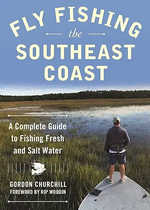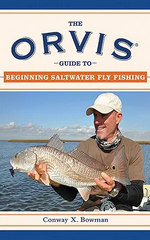One of the problems with fly casting is that it takes a lot of space, particularly for a back cast. Sometimes we have limited space because of trees, shrubs or high marsh behind us, limiting our ability to make an adequate and effective back cast necessary to have a good forward cast. This is where a roll cast or a steeple cast may com in handy. A steeple cast is simply a back cast that goes almost straight up. Tight loops are quite a bit harder with this approach but it’s even harder digging out a fly caught in a tall tree. The roll cast is often a good option. We will deal with roll casts in a separate epistle.
For the time being, let us focus on the need to have a No Cast Zone. For instance, when we are being guided on a float trip, a No Cast Zone is imperative. You don’t want to catch the guide in the back of the neck. You might find yourself having to walk on water to get home. Not only do you have to worry about the guide sitting in the middle of the boat but your friend who is fishing at the other end.
Ordinarily, a right hand caster sitting in the front of a drift boat finds is easier to cast to the left side (port) of the boat or to the right side (starboard) if sitting in the rear. You can cast to port over the bow of the boat if sitting in the front and to starboard over the stern if sitting in the rear. But sometimes the guide wants you to cast to the right (starboard) from the front or to the left (port) from the rear. That’s tough for a right-handed caster.
There are three basic ways you can cast to reduce the chances of hitting the guide or the other angler with a fly.
1. Use a cross-body cast. This involves holding the rod in your right hand but tilting the rod so you are casting over your left shoulder. This is easier said than done. One of the temptations is to try to exert extra power to the cast to overcome the awkwardness of the casting stance. But too much power will ruin your cast. You need to remember how easily you can cast over your right shoulder and try to cast just as easily over your left. You will be amazed and how much better your cross-body casts are when you don’t think about it too much and try to overpower it. Practice you cross-body cast in your yard or at a pond. Get comfortable with it and you will be amazed how well you can cast.
2. You can use a backward cast. Simply turn around and face the other way, as though you were going to be casting on the left (port) side of the boat. But the cast in front of you will be your back cast and your second cast will be aimed behind you as a forward cast. Since you are not facing the direction your final cast is going to go, accuracy will be a problem. Also, there will be the temptation to add extra power to the former back cast that is now your forward cast. Resist the temptation to try to compensate by adding extra power. As with the cross-body cast, practice this until you feel comfortable with this cast, have reasonable distance and reasonable accuracy. If you do much fishing from a boat, this will be a cast that will be extremely helpful.
3. The third option will require the most practice but will be very beneficial if you can do it. Learn to cast with your off-hand. If you are a right-handed caster, learn to cast with your left hand. Interestingly you may find that using your off-hand for casting isn’t that hard. What is hard, though, is teaching the muscles of your dominant hand how to do a haul and manage the fishing line. But it can be done and you will be glad you spent the time learning if you wind up having medical issues with your dominant hand/arm/shoulder down the road. If you can be as switch hitter (or caster), you will always be welcome on anyone’s boat because the captain can have both anglers fishing on the same side of the boat without danger of getting hit in the head with a fly.
These three casts (plus the roll cast) can help keep you out of trouble with your guide and fishing partner. So it is imperative you learn them all.



